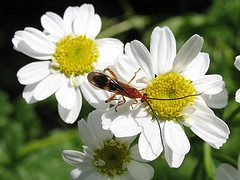

The genome packaged within polydnavirus capsids consists of multiple circles of dsDNA (30 for the Cotesia congregata bracovirus for a total of 560 kb). The viral DNA is integrated into the wasp genome and is therefore transmitted vertically. However, virions are produced only in the wasp ovaries. When the polydnavirus is injected into the caterpillar, no genome replication occurs, although viral mRNAs and proteins are produced. These proteins are essential for successful maturation of the wasp in the larval host.
To identify the polydnavirus capsid proteins, the authors sought related genes expressed in wasp pupal ovaries at times of maximal viral particle production. By sequencing DNA copies of wasp mRNAs, they identified 22 genes related to those of nudiviruses, ancient viruses similar to baculoviruses. The genes encode subunits of DNA-dependent RNA polymerase and structural proteins. Curiously, no genes encoding DNA polymerase were identified, suggesting that polydnavirus DNA is copied by wasp enzymes. The implication is that the enzymes for polydnavirus mRNA and capsid synthesis are produced in the wasp ovary from nudivirus genes.
There are other examples of defective viruses that do not encode capsid proteins. The RNA genome of hepatitis delta virus is encapsidated within hepatitis B virus particles, which is provided in co-infected cells. Similar satellites of plants depend upon co-infection with a helper virus to provide capsid proteins. The wasp polydnaviruses are unique because the capsid proteins are not provided by another virus, but by the wasp host. In turn, the wasp needs the virus to survive – closing the circle on a highly unusual symbiotic relationship.
A. Bezier, M. Annaheim, J. Herbiniere, C. Wetterwald, G. Gyapay, S. Bernard-Samain, P. Wincker, I. Roditi, M. Heller, M. Belghazi, R. Pfister-Wilhem, G. Periquet, C. Dupuy, E. Huguet, A.-N. Volkoff, B. Lanzrein, J.-M. Drezen (2009). Polydnaviruses of Braconid Wasps Derive from an Ancestral Nudivirus Science, 323 (5916), 926-930 DOI: 10.1126/science.1166788

do the polydnavirus dsDNA “circles” share any similarity with bacterial plasmids (other than their basic topology, of course)? I have always wondered this with viruses with cccDNA genomes. I seem to remember an unusual virus of the archaeon Sulfolobus that had a cccDNA genome (then, of course, certain phages). OK, now I am getting out “Virus Taxonomy”–I have a lot of work to do today and shouldn't have checked this blog…
Hi Michael,
There aren't any sequence elements shared between the polydnavirus
genome and bacterial plasmids. Both are superhelical closed circles as
you write, but have nothing else in common. Many other viral genomes
have the same topology (polyomavirus, papillomavirus to name two).
do the polydnavirus dsDNA “circles” share any similarity with bacterial plasmids (other than their basic topology, of course)? I have always wondered this with viruses with cccDNA genomes. I seem to remember an unusual virus of the archaeon Sulfolobus that had a cccDNA genome (then, of course, certain phages). OK, now I am getting out “Virus Taxonomy”–I have a lot of work to do today and shouldn't have checked this blog…
Hi Michael,
There aren't any sequence elements shared between the polydnavirus
genome and bacterial plasmids. Both are superhelical closed circles as
you write, but have nothing else in common. Many other viral genomes
have the same topology (polyomavirus, papillomavirus to name two).
Looks like you’ve done your research very well.